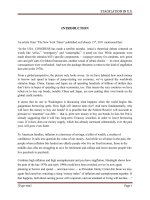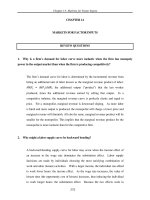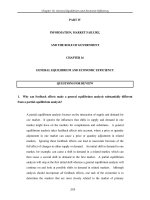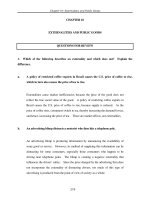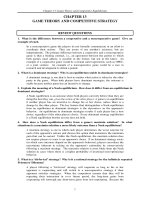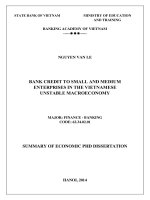file tiếng anh kinh tế vi mô - Môn Kinh tế vi mô
Bạn đang xem bản rút gọn của tài liệu. Xem và tải ngay bản đầy đủ của tài liệu tại đây (1.08 MB, 28 trang )
<span class="text_page_counter">Trang 1</span><div class="page_container" data-page="1">
Fernando & Yvonn Quijano
</div><span class="text_page_counter">Trang 2</span><div class="page_container" data-page="2">9.1 Evaluating the Gains and Losses from Government Policies—Consumer and Producer Surplus
9.2 The Efficiency of a Competitive Market 9.3 Minimum Prices
9.4 Price Supports and Production Quotas 9.5 Import Quotas and Tariffs
9.6 The Impact of a Tax or Subsidy
</div><span class="text_page_counter">Trang 3</span><div class="page_container" data-page="3">EVALUATING THE GAINS AND LOSSES FROM GOVERNMENT POLICIES—
CONSUMER AND PRODUCER SURPLUS
Review of Consumer and Producer Surplus
<i>Consumer A would pay $10 </i>
for a good whose market price is $5 and therefore enjoys a benefit of $5.
<i>Consumer B enjoys a benefit </i>
of $2,
<i>and Consumer C, who values </i>
the good at exactly the market price, enjoys no benefit.
Consumer surplus, which measures the total benefit to all consumers, is the yellow-shaded area between the demand curve and the market price.
<b><small>Consumer and Producer Surplus</small></b>
<b><small>Figure 9.1</small></b>
</div><span class="text_page_counter">Trang 4</span><div class="page_container" data-page="4">EVALUATING THE GAINS AND LOSSES FROM GOVERNMENT POLICIES—
CONSUMER AND PRODUCER SURPLUS
Review of Consumer and Producer Surplus
Producer surplus measures the total profits of producers, plus rents to factor inputs. It is the benefit that lower-cost producers enjoy by selling at the market price, shown by the green-shaded area between the supply curve and the market price. Together, consumer and producer surplus measure the welfare benefit of a competitive market.
<b><small>Consumer and Producer Surplus (continued)</small></b>
<b><small>Figure 9.1</small></b>
</div><span class="text_page_counter">Trang 5</span><div class="page_container" data-page="5">EVALUATING THE GAINS AND LOSSES FROM GOVERNMENT POLICIES—
CONSUMER AND PRODUCER SURPLUS
Application of Consumer and Producer Surplus
<b>●welfare effects </b>Gains and losses to consumers and producers.
The price of a good has been regulated to be no higher than
<i>P</i><sub>max</sub>, which is below the
<i>market-clearing price P</i><sub>0</sub>. The gain to consumers is the
<i>difference between rectangle Aand triangle B.</i>
The loss to producers is the
<i>sum of rectangle A and triangle </i>
<i>C. </i>
<i>Triangles B and C together </i>
measure the deadweight loss from price controls.
<b><small>Change in Consumer and Producer Surplus from Price Controls</small></b>
<b><small>Figure 9.2</small>●deadweight loss </b>Net loss of total (consumer plus producer) surplus.
</div><span class="text_page_counter">Trang 6</span><div class="page_container" data-page="6">EVALUATING THE GAINS AND LOSSES FROM GOVERNMENT POLICIES—
CONSUMER AND PRODUCER SURPLUS
Application of Consumer and Producer Surplus
If demand is sufficiently inelastic, triangle B can be larger than rectangle A. In this case, consumers suffer a net loss from price controls.
<b><small>Effect of Price Controls When Demand Is Inelastic</small></b>
<b><small>Figure 9.3</small></b>
</div><span class="text_page_counter">Trang 7</span><div class="page_container" data-page="7"><b>EVALUATING THE GAINS AND LOSSES FROM GOVERNMENT POLICIES—CONSUMER AND PRODUCER SURPLUS</b>
The deadweight loss is
<i>the sum of triangles Bplus C.</i>
<b><small>Effects of Natural Gas Price Controls</small></b>
<b><small>Figure 9.4</small></b>
</div><span class="text_page_counter">Trang 8</span><div class="page_container" data-page="8"><b>●economic efficiency </b>Maximization of aggregate consumer and producer surplus.
<b>●market failure </b>Situation in which an unregulated competitive market is inefficient because prices fail to provide proper signals to consumers and producers.
<b>●externality </b>Action taken by either a producer or a consumer which affects other producers or consumers but is not accounted for by the market price.
</div><span class="text_page_counter">Trang 9</span><div class="page_container" data-page="9">When price is regulated to be
<i>no lower than P</i><sub>2</sub><i>, only Q</i><sub>3</sub> will be demanded.
<i>If Q</i><sub>3</sub> is produced, the
deadweight loss is given by
<i>triangles B and C. </i>
<i>At price P</i><sub>2</sub>, producers would
<i>like to produce more than Q</i><sub>3</sub>. If they do, the deadweight loss will be even larger.
<b><small>Welfare Loss When Price is Held Above Market-Clearing Level</small></b>
<b><small>Figure 9.5</small></b>
</div><span class="text_page_counter">Trang 10</span><div class="page_container" data-page="10">The market-clearing price is $20,000; at this price, about 24,000 kidneys per year would be supplied.
The law effectively makes the price zero. About 16,000 kidneys per year are still donated; this constrained supply is shown as S’.
The loss to suppliers is given by rectangle A and triangle C. If consumers received kidneys at no cost, their gain would be given by rectangle A less triangle B.
<b><small>The Market for Kidneys and the Effect of the National Organ Transplantation Act</small></b>
<b><small>Figure 9.6</small></b>
</div><span class="text_page_counter">Trang 11</span><div class="page_container" data-page="11">In practice, kidneys are often rationed on the basis of
willingness to pay, and many recipients pay most or all of the $40,000 price that clears the market when supply is constrained.
Rectangles A and D measure the total value of kidneys when supply is constrained.
<b><small>The Market for Kidneys and the Effect of the National Organ Transplantation Act (continued)</small></b>
<b><small>Figure 9.6</small></b>
</div><span class="text_page_counter">Trang 12</span><div class="page_container" data-page="12"><i>Producers would like to supply Q</i><sub>2</sub>,
<i>but consumers will buy only Q</i><sub>3</sub>.
<i>If producers indeed produce Q</i><sub>2</sub>,
<i>the amount Q</i><sub>2</sub><i>− Q</i><sub>3 </sub>will go unsold and the change in producer
<i>surplus will be A− C − D. In this </i>
case, producers as a group may be worse off.
<b><small>Welfare Loss When Price is Held Above Market-Clearing Level</small></b>
<b><small>Figure 9.7</small></b>
</div><span class="text_page_counter">Trang 14</span><div class="page_container" data-page="14"><i>At price P</i><sub>min</sub>, airlines would
<i>like to supply Q</i><sub>2</sub>, well above
<i>the quantity Q</i><sub>1</sub> that consumers will buy.
<i>Here they supply Q</i><sub>3</sub>.
<i>Trapezoid D is the cost of </i>
unsold output.
Airline profits may have been lower as a result of regulation because triangle
<i>C and trapezoid D can </i>
together exceed rectangle
In addition, consumers lose
<i>A + B.</i>
<b><small>Effect of Airline Regulation by the Civil Aeronautics Board</small></b>
<b><small>Figure 9.9</small></b>
</div><span class="text_page_counter">Trang 15</span><div class="page_container" data-page="15"><small>Passenger Mile Rate </small>
<small>(Constant 1995 dollars)</small> .218 .210 .165 .150 .129 .118 .092 <small>Real Cost Index (1995 = 100)</small> 101 122 111 109 100 101 93 <small>Real Fuel Cost Index (1995 = </small>
<small>Real Cost Index Corrected for </small>
By 1981, the airline industry had been completely deregulated. Since that time, many new airlines have begun service, others have gone out of business, and price
competition has become much more intense. Because airlines have no control over oil prices, it is more informative to examine a ―corrected‖ real cost index which
removes the effects of changing fuel costs.
</div><span class="text_page_counter">Trang 16</span><div class="page_container" data-page="16"><i>To maintain a price P<sub>s</sub></i> above the
<i>market-clearing price P</i><sub>0</sub>, the
<i>government buys a quantity Q</i><sub>g</sub>.
<i>The gain to producers is A + B + </i>
<i>D. The loss to consumers is A + B. </i>
The cost to the government is the speckled rectangle, the area of
<i>which is P<sub>s</sub>(Q</i><sub>2</sub><i>− Q</i><sub>1</sub>).
<b><small>Prince Supports</small></b>
<b><small>Figure 9.10</small></b>
<b>●price support </b>Price set by government above free market level and maintained by governmental purchases of excess supply.
Price Supports
</div><span class="text_page_counter">Trang 17</span><div class="page_container" data-page="17"><i>To maintain a price P<sub>s</sub></i> above the
<i>market-clearing price P</i><sub>0</sub>, the government can restrict supply to
<i>Q</i><sub>1</sub>, either by imposing production quotas (as with taxicab medallions) or by giving producers a financial incentive to reduce output (as with acreage limitations in agriculture). For an incentive to work, it must be
<i>at least as large as B + C + D, </i>
which would be the additional profit earned by planting, given the higher
<i>price P<sub>s</sub></i>. The cost to the
<i>government is therefore at least B + </i>
</div><span class="text_page_counter">Trang 18</span><div class="page_container" data-page="18"><i>Loss to consumers = −A − B = $624 million</i>
Cost to the government = $3.70 x 112 million = $451.4 million
Total cost of the program = $624 million + $451.4 million = $1075 million
<i>Gain to producers = A + B + C = $638 million</i>
</div><span class="text_page_counter">Trang 19</span><div class="page_container" data-page="19">In 1985, the demand for wheat was much lower
</div><span class="text_page_counter">Trang 20</span><div class="page_container" data-page="20">In a free market, the domestic
<i>price equals the world price P<sub>w</sub></i>.
<i>A total Q<sub>d</sub></i> is consumed, of which
<i>Q<sub>s</sub></i> is supplied domestically and the rest imported.
When imports are eliminated, the price is
<i>increased to P</i><sub>0</sub>.
The gain to producers is
<i>trapezoid A. </i>
<i>The loss to consumers is A + B+ C, so the deadweight loss is B</i>
</div><span class="text_page_counter">Trang 21</span><div class="page_container" data-page="21">When imports are reduced, the domestic price is increased from
If a tariff is used, the
<i>government gains D, the </i>
revenue from the tariff. The net
<i>domestic loss is B + C.</i>
If a quota is used instead,
<i>rectangle D becomes part of the </i>
profits of foreign producers, and
<i>the net domestic loss is B + C + </i>
<b><small>Import Tariff or Quota (General Case)</small></b>
<b><small>Figure 9.15</small></b>
</div><span class="text_page_counter">Trang 22</span><div class="page_container" data-page="22">At the world price of 12 cents per pound, about 23.9 billion pounds of sugar would have been
consumed in the United States in 2005, of which all but 2.6 billion pounds
would have been imported.
</div><span class="text_page_counter">Trang 23</span><div class="page_container" data-page="23">The gain to domestic
<i>producers was trapezoid A, </i>
about $1.3 billion.
<i>Rectangle D, $795 million, </i>
was a gain to those foreign producers who obtained quota allotments.
<i>Triangles B and C</i>
represent the deadweight loss of about $1.2 billion.
<i>The cost to consumers, A + </i>
<i>B + C + D, was about $3.3 </i>
<b><small>Sugar Quota in 2005 (continued)</small></b>
<b><small>Figure 9.16</small></b>
</div><span class="text_page_counter">Trang 24</span><div class="page_container" data-page="24"><i>P<sub>b</sub></i>is the price (including the
<i>tax) paid by buyers. P</i><sub>s</sub> is the price that sellers receive, less the tax.
Here the burden of the tax is split evenly between buyers
<b>●specific tax </b>Tax of a certain amount of money per unit sold.
Market clearing requires four conditions to be satisfied after the tax is in place:
</div><span class="text_page_counter">Trang 25</span><div class="page_container" data-page="25">If demand is very inelastic relative to supply, the burden of the tax falls mostly on buyers.
<b><small>Impact of a Tax Depends on Elasticities of Supply and Demand</small></b>
<b><small>Figure 9.18</small></b>
If demand is very elastic relative to supply, it falls mostly on sellers.
</div><span class="text_page_counter">Trang 26</span><div class="page_container" data-page="26">A subsidy can be thought of as a negative tax. Like a tax, the benefit of a subsidy is split between buyers and sellers, depending on the relative elasticities of supply and demand.
<b><small>Figure 9.19</small></b>
The Effects of a Subsidy
Conditions needed for the market to clear with a subsidy:
<b>●subsidy </b>Payment reducing the buyer’s price below the seller’s price; i.e., a negative tax.
</div><span class="text_page_counter">Trang 27</span><div class="page_container" data-page="27">Annual revenue from the tax tQ = (1.00)(89) = $89 billion per year
Deadweight loss: (1/2) x ($1.00/gallon) x (11 billion gallons/year = $5.5 billion per year
</div><span class="text_page_counter">Trang 28</span><div class="page_container" data-page="28">The price of gasoline at the pump increases from $2.00 per gallon to
$2.44, and the quantity sold falls from 100 to 89 bg/yr.
Annual revenue from the tax is (1.00)(89) = $89
<i>billion (areas A + D). </i>
The two triangles show the deadweight loss of $5.5 billion per year.
<b><small>Impact of $1 Gasoline Tax</small></b>
<b><small>Figure 9.20</small></b>
</div>